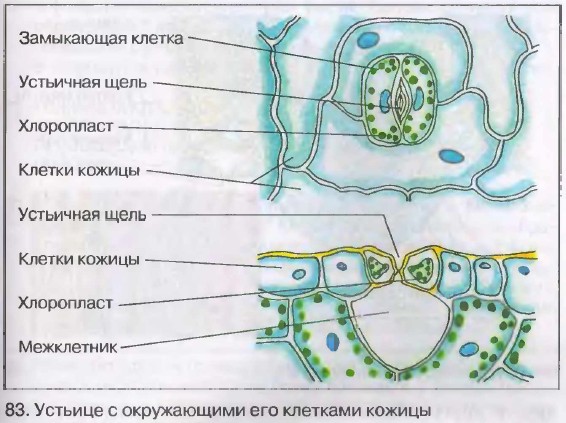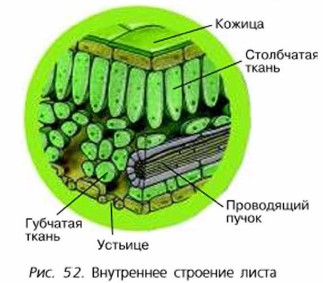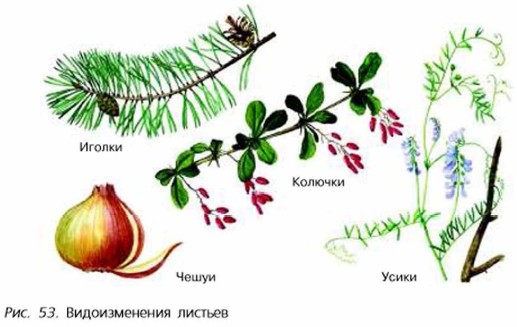§ 24. Cellular structure sheet
1. What is the function of the integumentary tissue? 2. What structural features do cells have? cover tissue? 3. What function do the cells of the main tissue perform and where are they located? 4. What are intercellular spaces?
Getting to know internal structure leaf blade will help you better understand the importance of green leaves in plant life.
Leaf skin structure
The top and bottom of the leaf are covered with a thin transparent skin; its cells protect the leaf from damage and drying out. Skin- one of the types of plant integumentary tissue.
Among the colorless and transparent skin cells there are located in pairs guard cells, the cytoplasm of which contains green plastids - chloroplasts. There is a gap between them. These cells and the gap between them are called stomata. Air enters the leaf through the stomatal fissure and water evaporates.
In most plants, stomata are located mainly on the skin of the underside of the leaf blade. On the leaves aquatic plants floating on the surface of the water, stomata are found only on the upper side of the leaf, and on underwater leaves there are no stomata at all. The number of stomata is huge. So, on a linden leaf there are more than a million of them, and on a cabbage leaf there are several million stomata.

Laboratory works
Leaf skin structure
1. Take a piece of clivia leaf (amaryllis, pelargonium, tradescantia), break it and carefully remove a small section of thin transparent skin from the underside. Prepare the preparation in the same way as the onion skin preparation. Examine under a microscope. (You can use ready-made leaf peel preparations.)
2. Look for discolored skin cells. Consider their shape and structure. What cells are they similar to that you already know?
3. Find stomatal cells? How are stomatal cells different from other onion skin cells?
4. Sketch the onion skin under a microscope. Separately sketch the stomata. Write captions for the drawings.
5. Draw a conclusion about the meaning of the leaf skin.
Under the skin is the leaf pulp, consisting of cells of the main tissue. Two or three layers directly adjacent to the upper skin are formed by elongated cells tightly adjacent to each other. They almost resemble same size columns, therefore top part the main tissue of the leaf is called columnar. There are especially many chloroplasts in the cytoplasm of these cells.

Beneath the columnar tissue lie more rounded or irregular shape cells. They do not fit tightly to each other. The intercellular spaces are filled with air. There are fewer chloroplasts in these cells than in cells columnar fabric. These cells form spongy tissue.
Getting to know the internal structure of the leaf blade will help you better understand the importance of green leaves in plant life.
Skin structure
The top and bottom of the sheet are covered with a thin transparent peel, its cells protect the leaf from damage and drying out. Among the colorless and transparent cells of the skin, there are guard cells located in pairs, the cytoplasm of which contains green plastids - chloroplasts. There is a gap between them. These cells and the gap between them are called stomata(Fig. 51). Through stomatal fissure Air enters the leaf and water evaporates.
In most species, stomata are located mainly on the skin of the underside of the leaf blade. On the leaves of aquatic species floating on the surface of the water, stomata are found only on the upper side of the leaf, and on underwater leaves there are no stomata at all.
The structure of the leaf pulp

Under the skin is leaf pulp, consisting of cells of the main tissue (Fig. 52); 2-3 layers immediately adjacent to the upper skin are formed by elongated cells tightly adjacent to each other. They resemble columns of almost the same size, so the upper part of the main leaf tissue is called columnar. There are especially many chloroplasts in the cytoplasm of these cells.
Beneath the columnar tissue lie more rounded or irregularly shaped cells. They do not fit tightly to each other. The intercellular spaces are filled with air. There are fewer chloroplasts in these cells than in the cells of columnar tissue. These cells form spongy tissue.
Structure of leaf veins
If you examine a cross section of a leaf blade under a microscope, you can see conductive leaf bundles- veins consisting of vessels, sieve tubes and fibers (see Fig. 52). Strongly elongated cells with thick walls - fibers - give the sheet strength. By vessels water and dissolved in it move minerals. Sieve tubes, unlike vessels, are formed by living long cells. The transverse partitions between them are pierced by narrow channels and look like sieves. Solutions of organic substances move through sieve tubes from the leaves to the roots.
The shape, size and structure of the leaves largely depend on the living conditions of the plants.
Leaves and humidity factor
The leaves of plants in humid places are usually large, with big amount stomata A lot of moisture evaporates from the surface of these leaves. Such plants include monstera, ficus, and begonia, which are often grown in rooms.
The leaves of plants in arid places are small in size and have adaptations that reduce evaporation. These are dense pubescence, a waxy coating, a relatively small number of stomata, etc. Some plants (aloe, agave) have soft and succulent leaves. They store water.
Leaves and lighting conditions
The leaves of shade-tolerant plants have only 2-3 layers of rounded cells, loosely adjacent to each other. Large chloroplasts are located in them so that they do not shade each other. Shadow leaves, as a rule, are thinner and have a dark green color, as they contain more chlorophyll.
In plants in open areas, the leaf pulp has several layers tightly adjacent to each other. columnar cells. They contain less chlorophyll, so they are lighter in color. Both leaves can sometimes be found in the crown of the same tree.
In the process of adapting to conditions environment The leaves of some plants have changed because they began to play a role that is not characteristic of typical leaves. For example, in barberry, some of the leaves have changed into spines (Fig. 53). They turned into spines and leaves of cacti: they evaporate less moisture and protect plants from being eaten by animals. In peas, the upper parts of the leaves are turned into tendrils. They serve to maintain the plant stem in an upright position.

